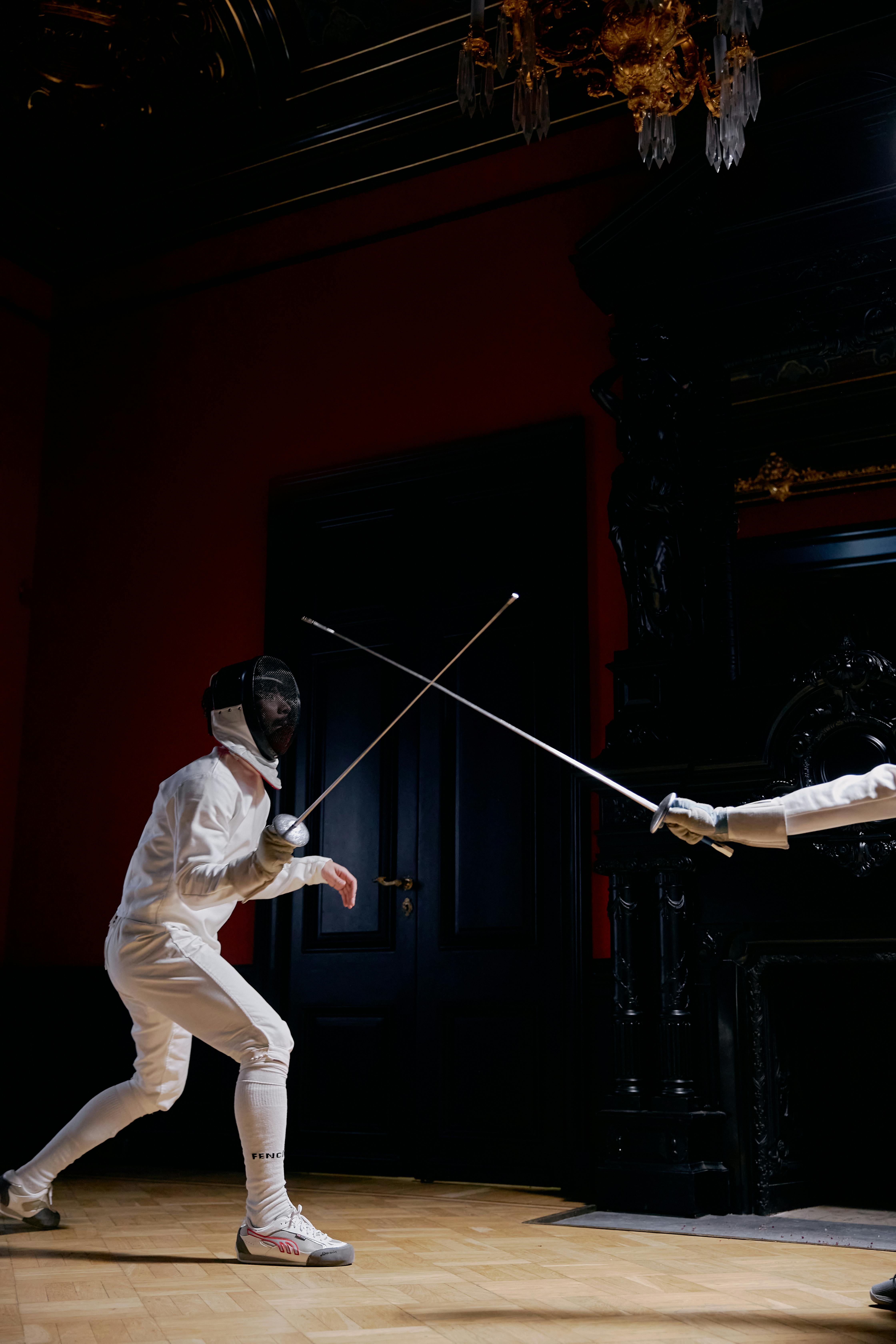Fencing is a sport that requires precision, speed, and strategy. It is a physical and mental game that has been around for centuries, with its roots tracing back to ancient civilizations. As with any sport, fencing has its own set of terminology and vocabulary that may seem confusing to those who are new to the sport. In this comprehensive guide, we will break down the essential fencing terms and explain their meanings, helping you to better understand the language of fencing.
Introduction to Fencing Terms


Before delving into the specific terms used in fencing, it is important to understand the basics of the sport. Fencing is a combat sport that involves two opponents using swords to score points against each other. The objective is to touch your opponent with the tip of your sword while avoiding being touched yourself. Fencing is divided into three disciplines: foil, epee, and sabre. Each discipline has its own set of rules and techniques, which will be discussed in more detail later on.
Understanding Basic Fencing Terminology


To fully grasp the intricacies of fencing, it is crucial to have a solid understanding of the basic terminology used in the sport. Here are some of the most common terms you will encounter in fencing:
En garde
En garde is the starting position in fencing. It is a French term that means “on guard” and is used to signal the beginning of a bout (a fencing match). In this position, the fencer stands with their feet shoulder-width apart, knees slightly bent, and their sword arm extended forward.
Lunge
The lunge is a fundamental movement in fencing where the fencer extends their front leg forward while keeping their back leg stationary. This movement allows the fencer to reach their opponent and score a point. It is often accompanied by a thrusting motion with the sword.
Parry
A parry is a defensive move in fencing where the fencer uses their sword to deflect their opponent’s attack. It involves moving the sword in a controlled manner to block or redirect the opponent’s blade. There are several types of parries, each with its own designated number and name.
- Prime (1): A parry that moves the sword from high to low on the outside line.
- Seconde (2): A parry that moves the sword from low to high on the inside line.
- Tierce (3): A parry that moves the sword from high to low on the inside line.
- Quarte (4): A parry that moves the sword from low to high on the outside line.
- Quinte (5): A parry that moves the sword from high to low on the center line.
- Sixte (6): A parry that moves the sword from low to high on the center line.
- Septime (7): A parry that moves the sword from high to low on the outside line, but with the hand held in a pronated position.
- Octave (8): A parry that moves the sword from low to high on the outside line, but with the hand held in a supinated position.
Riposte
A riposte is an offensive action taken immediately after successfully parrying your opponent’s attack. It is a quick counterattack that aims to score a point while the opponent is off balance.
Remise
A remise is similar to a riposte, but it is used when the initial attack fails to score a point. In this case, the fencer continues with a second attack without resetting to the en garde position.
Common Fencing Techniques and Their Terms


Fencing is a sport that requires both physical and mental agility. To be successful, fencers must master various techniques and strategies. Here are some of the most common techniques used in fencing and their associated terms:
Advance
An advance is a forward movement where the fencer takes a step with their front foot while keeping their back foot stationary. This technique is often used to close the distance between the fencers.
Retreat
A retreat is the opposite of an advance, where the fencer moves backward by taking a step with their back foot while keeping their front foot stationary. This technique is used to create distance between the fencers.
Feint
A feint is a deceptive move where the fencer makes a false attack to trick their opponent into reacting, allowing them to score a point with a real attack.
Beat
A beat is a sharp tap on the opponent’s blade to disrupt their defense and create an opening for an attack.
Disengage
A disengage is a maneuver where the fencer changes the line of their attack by moving their sword around their opponent’s blade.
Flick
A flick is a quick and light touch with the tip of the sword. It is often used to score points on hard-to-reach areas of the body, such as the back or shoulder.
Fencing Equipment and Associated Terms
Fencing requires specific equipment to ensure the safety of the fencers and to maintain the integrity of the sport. Here are some of the essential equipment used in fencing and their associated terms:
Foil
The foil is a type of sword used in the discipline of foil fencing. It is a lightweight weapon with a flexible blade that is designed for thrusting attacks.
Epee
The epee is a type of sword used in the discipline of epee fencing. It is similar to the foil but has a stiffer blade and a larger guard to protect the hand.
Sabre
The sabre is a type of sword used in the discipline of sabre fencing. It is the only weapon in fencing that allows for both thrusting and cutting actions.
Mask
The mask is a protective headgear worn by fencers to protect their face from accidental hits. It is made of a strong metal mesh and is designed to withstand the force of a sword.
Jacket
The jacket is a padded garment worn by fencers to protect their upper body from hits. It is made of a thick material that can absorb the impact of a sword.
Glove
The glove is a protective gear worn on the sword hand to prevent injuries. It is usually made of leather or synthetic materials and has a reinforced palm to provide a better grip on the sword.
Glossary of Essential Fencing Terms

To help you navigate the world of fencing terminology, here is a glossary of essential terms that you may encounter:
- Advance: A forward movement where the fencer takes a step with their front foot.
- Beat: A sharp tap on the opponent’s blade to disrupt their defense.
- Disengage: A maneuver where the fencer changes the line of their attack.
- En garde: The starting position in fencing.
- Epee: A type of sword used in epee fencing.
- Feint: A deceptive move to trick the opponent.
- Flick: A quick and light touch with the tip of the sword.
- Foil: A type of sword used in foil fencing.
- Glove: Protective gear worn on the sword hand.
- Lunge: A fundamental movement in fencing.
- Mask: Protective headgear worn by fencers.
- Parry: A defensive move using the sword.
- Remise: A second attack after a failed initial attack.
- Retreat: A backward movement.
- Riposte: A quick counterattack after successfully parrying.
- Sabre: A type of sword used in sabre fencing.
Advanced Fencing Terminology and Strategies
As fencers progress in their skills, they will encounter more advanced techniques and strategies. Here are some of the terms used to describe these advanced moves:
Compound Attack
A compound attack is a series of consecutive attacks that aim to confuse and overwhelm the opponent.
Counterattack
A counterattack is an offensive move taken while avoiding the opponent’s attack.
Disarm
A disarm is a move where the fencer knocks the sword out of their opponent’s hand.
Flèche
A flèche is an explosive forward movement where the fencer runs towards their opponent while extending their arm to score a point.
Redoublement
A redoublement is a second attack that follows a failed initial attack.
Fencing Rules and Regulations: Key Terms to Know
Fencing is a highly regulated sport with specific rules and regulations that must be followed. Here are some key terms related to fencing rules and regulations:
Priority
Priority is a rule that determines which fencer has the right of way when both fencers score a point simultaneously. The fencer who initiated the attack is given priority and awarded the point.
Right of Way
Right of way refers to the right to score a point in a simultaneous attack. It is given to the fencer who initiated the attack first.
Non-combativity
Non-combativity is a rule that penalizes fencers for not engaging in enough action during a bout. If both fencers receive two non-combativity warnings, they will be penalized with a yellow card.
Yellow Card
A yellow card is a warning given to fencers for breaking a rule or not following the code of conduct. Two yellow cards result in a red card, which leads to disqualification from the bout.
Famous Fencing Terms and Phrases
Over the years, fencing has produced many famous fencers who have left their mark on the sport. Here are some famous fencing terms and phrases associated with these legendary fencers:
En garde, prêt, allez!
This phrase is used to signal the start of a bout and was popularized by French fencer Aldo Nadi.
Touché
Derived from the French word “touched,” this term is used to acknowledge when a point has been scored.
Inquartata
Inquartata is a technique where the fencer turns their body to protect their flank while attacking. It was invented by Italian fencer Salvatore Pecoraro.
The Fleche Attack
The fleche attack was made famous by Hungarian fencer Aladar Gerevich, who won six consecutive Olympic gold medals using this technique.
Fencing Slang: What Do They Mean?
Like any sport, fencing has its own set of slang terms that may not be familiar to those outside of the fencing community. Here are some common fencing slang terms and their meanings:
- Flicky: A term used to describe a fencer who relies heavily on flick attacks.
- On guard: A term used to describe someone who is always ready for action.
- Point control: The ability to manipulate the sword with precision and accuracy.
- Riposte queen/king: A fencer who excels at ripostes.
- Sabreur: A fencer who specializes in sabre.
- Touch whore: A fencer who focuses solely on scoring points rather than practicing proper technique.
Mastering Fencing Vocabulary: Tips and Tricks
Learning fencing terminology can seem overwhelming at first, but with practice and dedication, you will soon become fluent in the language of fencing. Here are some tips and tricks to help you master fencing vocabulary:
- Watch fencing matches: Watching professional fencers in action is a great way to familiarize yourself with the terminology and see how it is used in a real-life setting.
- Read fencing books and articles: There are many books and articles written about fencing that can help you understand the terminology in more detail.
- Practice with a coach: A fencing coach can not only teach you the techniques but also explain the terminology and its proper usage.
- Use flashcards: Create flashcards with the terms and their definitions to help you memorize them.
- Join a fencing club: Being around other fencers and immersing yourself in the sport will help you pick up the terminology quickly.
Conclusion
Fencing is a sport that requires skill, strategy, and a deep understanding of its terminology. By familiarizing yourself with the essential fencing terms and practicing regularly, you will be well on your way to mastering this ancient sport. Remember, learning fencing vocabulary takes time and patience, so don’t get discouraged if you don’t grasp it all at once. With dedication and perseverance, you will soon become fluent in the language of fencing.